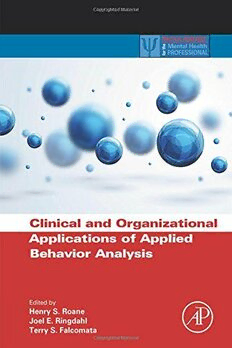
Clinical and Organizational Applications of Applied Behavior Analysis PDF
Preview Clinical and Organizational Applications of Applied Behavior Analysis
CLINICAL AND ORGANIZATIONAL APPLICATIONS OF APPLIED BEHAVIOR ANALYSIS CLINICAL AND ORGANIZATIONAL APPLICATIONS OF APPLIED BEHAVIOR ANALYSIS Edited by HENRY S. ROANE UpstateMedicalUniversity, Syracuse, New York, USA JOEL L. RINGDAHL Rehabilitation Institute,Southern Illinois University, Carbondale, Illinois, USA TERRY S. FALCOMATA Department of Special Education, The University of Texas at Austin, Austin,Texas, USA AMSTERDAM (cid:129) BOSTON (cid:129) HEIDELBERG (cid:129) LONDON NEW YORK (cid:129) OXFORD (cid:129) PARIS (cid:129) SAN DIEGO SAN FRANCISCO (cid:129) SINGAPORE (cid:129) SYDNEY (cid:129) TOKYO Academic Press is an imprint of Elsevier AcademicPressisanimprintofElsevier 125LondonWall,London,EC2Y5AS,UK 525BStreet,Suite1800,SanDiego,CA92101-4495,USA 225WymanStreet,Waltham,MA02451,USA TheBoulevard,LangfordLane,Kidlington,OxfordOX51GB,UK Firstpublished2015 Copyright©2015ElsevierInc.Allrightsreserved. Nopartofthispublicationmaybereproducedortransmittedinanyformorbyany means,electronicormechanical,includingphotocopying,recording,oranyinformation storageandretrievalsystem,withoutpermissioninwritingfromthepublisher.Detailson howtoseekpermission,furtherinformationaboutthePublisher’spermissionspolicies andourarrangementwithorganizationssuchastheCopyrightClearanceCenterandthe CopyrightLicensingAgency,canbefoundatourwebsite:www.elsevier.com/permissions Thisbookandtheindividualcontributionscontainedinitareprotectedundercopyright bythePublisher(otherthanasmaybenotedherein). Notices Knowledgeandbestpracticeinthisfieldareconstantlychanging.Asnewresearchand experiencebroadenourunderstanding,changesinresearchmethods,professional practices,ormedicaltreatmentmaybecomenecessary. Practitionersandresearchersmustalwaysrelyontheirownexperienceandknowledge inevaluatingandusinganyinformation,methods,compounds,orexperimentsdescribed herein.Inusingsuchinformationormethodstheyshouldbemindfuloftheirownsafety andthesafetyofothers,includingpartiesforwhomtheyhaveaprofessionalresponsibility. Tothefullestextentofthelaw,neitherthePublishernortheauthors,contributors, oreditors,assumeanyliabilityforanyinjuryand/ordamagetopersonsorpropertyas amatterofproductsliability,negligenceorotherwise,orfromanyuseoroperation ofanymethods,products,instructions,orideascontainedinthematerialherein. BritishLibraryCataloguinginPublicationData AcataloguerecordforthisbookisavailablefromtheBritishLibrary LibraryofCongressCataloging-in-PublicationData AcatalogrecordforthisbookisavailablefromtheLibraryofCongress ISBN:978-0-12-420249-8 ForinformationonallAcademicPresspublications visitourwebsiteatstore.elsevier.com PrintedandboundintheUnitedStates CONTRIBUTORS KeithD.Allen DepartmentofPsychology,Munroe-MeyerInstituteforGeneticsandRehabilitation, UniversityofNebraskaMedicalCenter,Omaha,Nebraska,USA ScottP.Ardoin DepartmentofEducationalPsychologyandInstructionalTechnology,Universityof Georgia,Athens,Georgia,USA JonathanC.Baker RehabilitationInstitute,SouthernIllinoisUniversity,Carbondale,Illinois,USA YvonneBarnes-Holmes DepartmentofPsychology,NationalUniversityofIrelandMaynooth,Co.,Kildare,Ireland BreanneJ.Byiers DepartmentofEducationalPsychology,UniversityofMinnesota,Minneapolis,Minnesota, USA JacobH.Daar RehabilitationInstitute,SouthernIllinoisUniversity,Carbondale,Illinois,USA JesseDallery DepartmentofPsychology,UniversityofFlorida,Gainesville,Florida,USA EdwardJ.DalyIII DepartmentofEducationalPsychology,UniversityofNebraskaLincoln,Lincoln,Nebraska, USA EricaDashow Rutgers,TheStateUniversityofNewJersey,DouglassDevelopmentalDisabilitiesCenter, NewBrunswick,NewJersey,USA AnthonyDefulio DepartmentofPsychiatryandBehavioralSciences,JohnsHopkinsUniversitySchoolof Medicine,Baltimore,Maryland,USA MarkR.Dixon RehabilitationInstitute,SouthernIllinoisUniversity,Carbondale,Illinois,USA KathleenM.Fairchild RehabilitationInstitute,SouthernIllinoisUniversity,Carbondale,Illinois,USA TerryS.Falcomata DepartmentofSpecialEducation,TheUniversityofTexasatAustin,Austin,Texas,USA WayneW.Fisher CenterforAutismSpectrumDisorders,Munroe-MeyerInstitute,TheUniversityof NebraskaMedicalCenter,Omaha,Nebraska,USA xiii xiv Contributors DanaM.Gadaire TheScottCenterforAutismTreatmentandFloridaInstituteofTechnology,Melbourne, Florida,USA CindyGevarter DepartmentofSpecialEducation,TheUniversityofTexasatAustin,Austin,Texas,USA HeatherK.Gonzales DepartmentofSpecialEducation,TheUniversityofTexasatAustin,Austin,Texas,USA NicoleL.Hausman DepartmentofBehavioralPsychology,TheKennedyKriegerInstitute,Baltimore, Maryland,USA JeffreyF.Hine DepartmentofPsychology,Munroe-MeyerInstituteforGeneticsandRehabilitation, UniversityofNebraskaMedicalCenter,Omaha,Nebraska,USA DavidC.Houghton DepartmentofPsychology,TexasA&MUniversity,CollegeStation,Texas,USA RobertW.Isenhower Rutgers,TheStateUniversityofNewJersey,DouglassDevelopmentalDisabilitiesCenter, NewBrunswick,NewJersey,USA SungWooKahng DepartmentofHealthPsychology,UniversityofMissouri,Columbia,Missouri,USA MichaelE.Kelley TheScottCenterforAutismTreatmentandFloridaInstituteofTechnology,Melbourne, Florida,USA MichelleKuhn DepartmentofSpecialEducation,TheUniversityofTexasatAustin,Austin,Texas,USA GiulioE.Lancioni DepartmentofEducation,UniversityofBari,Bari,Italy RussellLang DepartmentofCurriculumandInstruction,TexasStateUniversity,SanMarcos,Texas,USA RobertH.LaRue Rutgers,TheStateUniversityofNewJersey,DouglassDevelopmentalDisabilitiesCenter, NewBrunswick,NewJersey,USA LindaA.LeBlanc TrumpetBehavioralHealth,Lakewood,Colorado,USA DorotheaC.Lerman DepartmentofClinical,Health,andAppliedSciences,UniversityofHouston—ClearLake, Houston,Texas,USA Contributors xv ClareJ.Liddon TheScottCenterforAutismTreatmentandFloridaInstituteofTechnology,Melbourne, Florida,USA TimothyD.Ludwig DepartmentofPsychology,AppalachianStateUniversity,Boone,NorthCarolina,USA JamesK.Luiselli ClinicalSolutions,Inc.andNorthEastEducationalandDevelopmentalSupportCenter, Tewksbury,Massachusetts,USA BrianK.Martens DepartmentofPsychology,SyracuseUniversity,Syracuse,NewYork,USA MonicaM.Matthieu SchoolofSocialWork,StLouisUniversity,StLouis,Missouri,USA CiaraMcEnteggart DepartmentofPsychology,NationalUniversityofIrelandMaynooth,Co.,Kildare, Ireland HeatherM.McGee WesternMichiganUniversity,KalamazooMichigan,USA StevenE.Meredith DepartmentofPsychiatryandBehavioralSciences,JohnsHopkinsUniversitySchoolof Medicine,Baltimore,Maryland,USA SuzanneM.Milnes UniversityofNebraskaMedicalCenter’sMunroe-MeyerInstitute,Omaha,Nebraska,USA RaymondG.Miltenberger DepartmentofChildandFamilyStudies,UniversityofSouthFlorida,Tampa, Florida,USA MatthewP.Normand DepartmentofPsychology,UniversityofthePacific,Stockton,California,USA TritonOng DepartmentofPsychology,UniversityofthePacific,Stockton,California,USA MarkF.O’Reilly DepartmentofSpecialEducation,TheUniversityofTexasatAustin,Austin,Texas,USA KerriP.Peters PsychologyDepartment,UniversityofFlorida,Gainesville,Florida,USA CathleenC.Piazza UniversityofNebraskaMedicalCenter’sMunroe-MeyerInstitute,Omaha,Nebraska,USA DerekD.Reed DepartmentofAppliedBehavioralScience,UniversityofKansas,Lawrence,Kansas,USA xvi Contributors JoeE.Reichle DepartmentofEducationalPsychology,andDepartmentofSpeech-Language-Hearing Sciences,UniversityofMinnesota,Minneapolis,Minnesota,USA AureliaRibeiro TheScottCenterforAutismTreatmentandFloridaInstituteofTechnology,Melbourne, Florida,USA LauraRojeski DepartmentofSpecialEducation,TheUniversityofTexasatAustin,Austin,Texas,USA PatrickW.Romani Munroe-MeyerInstitute,UniversityofNebraskaMedicalCenter,Omaha,Nebraska,USA NicoletteSammarco DepartmentofSpecialEducation,TheUniversityofTexasatAustin,Austin,Texas,USA SindySanchez DepartmentofChildandFamilyStudies,UniversityofSouthFlorida,Tampa, Florida,USA KellyM.Schieltz CollegeofEducation,UniversityofMissouri,Columbia,Missouri,USA DawnA.Seefeldt RehabilitationInstitute,SouthernIllinoisUniversity,Carbondale,Illinois,USA RebeccaA.Shalev UniversityofNebraskaMedicalCenter’sMunroe-MeyerInstitute,Omaha,Nebraska,USA JeffSigafoos DepartmentofSpecialEducation,VictoriaUniversity,Wellington,NewZealand SigurdurO.Sigurdsson SchoolofBehaviorAnalysis,FloridaInstituteofTechnology,Melbourne,Florida,USA SarahK.Slocum PsychologyDepartment,UniversityofFlorida,Gainesville,Florida,USA KimberlyN.Sloman Rutgers,TheStateUniversityofNewJersey,DouglassDevelopmentalDisabilitiesCenter, NewBrunswick,NewJersey,USA DiegoA.Valbuena DepartmentofChildandFamilyStudies,UniversityofSouthFlorida,Tampa, Florida,USA AmberL.Valentino TrumpetBehavioralHealth,Lakewood,Colorado,USA TimothyR.Vollmer PsychologyDepartment,UniversityofFlorida,Gainesville,Florida,USA Contributors xvii DavidP.Wacker CenterforDisabilitiesandDevelopment,TheUniversityofIowa,IowaCity,Iowa,USA LaciWatkins DepartmentofSpecialEducation,TheUniversityofTexasatAustin,Austin,Texas,USA DavidA.Wilder SchoolofBehaviorAnalysis,FloridaInstituteofTechnology,Melbourne,Florida,USA AlyssaN.Wilson SchoolofSocialWork,StLouisUniversity,StLouis,Missouri,USA DouglasW.Woods DepartmentofPsychology,TexasA&MUniversity,CollegeStation,Texas,USA AmandaN.Zangrillo CenterforAutismSpectrumDisorders,Munroe-MeyerInstitute,TheUniversityof NebraskaMedicalCenter,Omaha,Nebraska,USA PREFACE The origin of this text arose from countless conversations with other pro- fessionalswhogenerallyreported,“Iknowaboutappliedbehavioranalysis. I’ve seen it done before.” Undoubtedly, many of those professionals had seen aversionof appliedbehavior analysis(or“ABA”asit isoften referred to)conductedwiththeirchild,student,orpatient;however,itbecameclear that others held a relatively restricted notion of ABA. Without doubt, one of the most notable utilizations of ABA has been within the context of the interventions relating to skill deficits and behaviors of excess displayed byindividualswithdevelopmentaldisabilities,specificallyautism.Although numerousproceduresandapproacheshavebeenpresentedaspotentialtreat- mentsforthebehavioralsymptomsofautism,thosebasedontheprinciples ofABAhavereceivedthemostempiricalsupport.Asaresult,inrecentyears, the term “applied behavior analysis” appears to be used quite often as a synonym for a very specific range of interventions for autism. ManyreaderswouldnotethatABAisbutasubfieldofthebroaderarea of behavior analysis that also includes: (a) behaviorism, which focuses on the world view, theory, or philosophy of behavior analysis, and (b) the experimental analysis of behavior (EAB), which focuses on identifying and analyzing the basic principles, mechanisms, and processes that explain behavior. ABAis distinct from EABin that it is considered a clinical disci- plineinwhichthegeneralprinciplesoflearningandbehaviorareappliedfor thepurposeofaddressingsociallyrelevantproblemsandissues.Thus,behav- ioranalystswhoworkinABAconductresearchthatassistsindevelopingand evaluatingevidence-basedpracticesdirectedtowardtheremedyofproblems associatedwithsociallysignificantbehavior.Appliedbehavioranalyststhen use the results of the applied research to create and implement effective evidence-basedproceduresinmorenaturalsettingssuchasschools,homes, and the community. Such work often focuses on behavioral problems that occur in particular settings, are associated with particular populations (e.g., individuals with autism or other developmental disabilities), and those that are present within larger social contexts (e.g., organizational behavior management). InlightoftheefficacyofABA-basedproceduresinaddressingbehaviors associatedwithautism,itisimportanttonotethattheprinciplesunderlying this therapeutic approach have been shown to be similarly effective when xix xx Preface appliedtootherpopulations,settings,andbehaviors.Thecurrenttextpro- videsareviewofsuchclinicalapplicationstowardthepurposeofexpanding the reader’s knowledge related to the breadth of ABA-based applications. Simply put, the goal is to illustrate the use of ABA beyond the realm of autism. ThecontentofthisbookwasidentifiedfromaninformalsurveyofABA practitionersandresearchersontheirknowledgeofcurrentareasofclinical practice. In general, an attempt was made to limit the proposed content to clinical applications which have been divided into four broad areas: child applications, adult applications, broad-based health applications, and appli- cationsintheareaoforganizationalbehaviormanagement.Undoubtedly,as thefieldcontinuestoexpanditsbreadth,therearesomeareasinwhichABA methodsareappliedtonovelareasofstudythatmayhavebeenomittedfrom inclusion. Theeditorshavedrawnuponarangeofsubject-matterexpertswhohave clinical and research experience in the application of ABA across multiple applicationstoserveascontributorstothisvolume.Agreatdealofthought was expended in determining whom we should contact for material on a givenchapter.Inmanycases,thedecisionwasdifficultasthereareanumber ofsubject-matterexpertswhowouldhavebeenappropriate.Inthemajority of cases, our initial approach to a potential contributor was met with an enthusiasticacceptance.Consequently,theresultingtextincludescontribu- tions from individuals who have served as editors, associate editors,or edi- torialboardmembersforprominentcontent-areajournalssuchastheJournal ofAppliedBehaviorAnalysis,theJournaloftheExperimentalAnalysisofBehavior, the Journal of Organizational Behavior Management, and the Behavior Analyst. Thisbookisbestsuitedasaprimarytextbookforcourseworkinbehavior analysis,psychology,oreducation.Also,whilepractitionersandstudentsare theultimatetargetsofthiswork,otherprofessionalsshouldfindthecontent andlanguagetobemanageable.Thehopeisthatthisvolumewillbeinfor- mative in demonstrating the range of application of ABA to various prob- lemsofsocialsignificance.Wehopethereaderfindsthisbookasenjoyableas it was to edit. Henry S. Roane Joel E. Ringdahl Terry S. Falcomata
